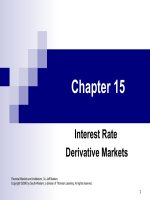Thị trường tài chính và các định chế tài chính_ Chapter 15
Bạn đang xem bản rút gọn của tài liệu. Xem và tải ngay bản đầy đủ của tài liệu tại đây (354.91 KB, 39 trang )
1
Chapter 15
Interest Rate
Derivative Markets
Financial Markets and Institutions, 7e, Jeff Madura
Copyright ©2006 by South-Western, a division of Thomson Learning. All rights reserved.
2
Chapter Outline
Background
Participation by financial institutions
Types of interest rate swaps
Risks of interest rate swaps
Pricing interest rate swaps
Factors affecting the performance of interest rate
swaps
Interest rate caps, floors, and collars
Globalization of swap markets
3
Background
An interest rate swap is an arrangement whereby one
party exchanges one set of interest payments for another
e.g., fixed-rate payments are exchanged for floating-rate
payments
The provisions of a swap include:
The notional principal
The fixed interest rate
The formula and type of index to determine the floating rate
The frequency of payments
The lifetime of the swap
4
Background (cont’d)
Amounts owed are typically netted out so that only the net payment is
made
The market for swaps is facilitated by over-the-counter trading
Swaps are less standardized than other derivatives
Swaps became popular in the early 1980s because of large
fluctuations in interest rates
e.g., financial institutions traditionally had more interest rate-sensitive
liabilities than assets and were adversely affected by rising interest
rates
e.g., some foreign financial institutions had access to long-term fixed
rate funding but used funds primarily for floating rate loans
By engaging in an interest rate swap, both institutions can reduce their
exposure to interest rate risk (see next slide)
5
Background (cont’d)
A U.S. financial institutions could send fixed-rate
payments to a European financial institution in exchange
for floating-rate payments
If interest rates rise, the U.S. financial institution receives higher
interest payments from the floating-rate portion, which helps to
offset the rising cost of obtaining deposits
If interest rates decline, the European institution provides lower
interest payments in the swap, which helps to offset the lower
interest payments received on its floating-rate loans
The U.S. institution forgoes the potential benefits from a decline in
interest rates
The European institution forgoes the potential benefits from an
increase in interest rates
6
Background (cont’d)
A primary reason for the popularity of swaps is
market imperfections
A lack of information about foreign institutions and
convenience encourages individual depositors to place
deposits locally
Swaps are sometimes used for speculative
purposes
e.g., a firm could engage in a swap to benefit from
rising interest rates even if its operations are not
exposed to interest rate movements
7
Participation by Financial
Institutions
Financial institutions that are exposed to interest
rate movements commonly engage in swaps to
reduce interest rate risk
Some commercial banks and securities firms
serve as intermediaries by matching up firms
and facilitating the swap arrangements
Charge fees and may provide credit guarantees
Some institutions act as dealers in swaps
The financial institution takes the counterparty position
in order to serve a client
8
Participation by Financial
Institutions
Financial Institution Participation in Swap Market
Commercial banks
Engage in swaps to reduce interest rate risk
Serve as an intermediary by matching up two parties in a swap
Serve as a dealer by taking the counterparty position to
accommodate a party the desires to engage in a swap
S&Ls and savings banks
Engage in swaps to reduce interest rate risk
Finance companies
Engage in swaps to reduce interest rate risk
Securities firms
Serve as an intermediary by matching up two parties in a swap
Serve as a dealer by taking the counterparty position to
accommodate a party that desires to engage in a swap
Insurance companies
Engage in swaps to reduce interest rate risk
Pension funds
Engage in swaps to reduce interest rate risk
9
Types of Interest Rate Swaps
Plain vanilla swaps
In a plain vanilla swap (fixed-for-floating
swap), fixed-rate payments are periodically
exchanged for floating-rate payments
Consider two scenarios:
A consistent rise in market interest rates
A consistent decline in market interest rates
10
Types of Interest Rate Swaps
(cont’d)
Plain vanilla swaps (cont’d)
Rising Interest Rates Declining Interest Rates
Level of
Interest Payments
End of Year
Fixed Outflow
Payments
Floating Inflow
Payments
Fixed Outflow
Payments
Floating Inflow
Payments
11
Using A Plain Vanilla Swap
Bruny Bank has negotiated a plain vanilla swap in
which it will exchange fixed payments of 8
percent for floating payments equal to LIBOR
plus 1 percent at the end of each of the next
four years. Assume that the notional principal is
$100 million. Fill in the table on the next slide
for the two scenarios of rising and falling
interest rates.
12
Scenario 1 Year
1 2 3 4
LIBOR 7.0% 7.5% 8.5% 9.5%
Floating rate received
Fixed rate paid
Swap differential
Net dollar amount received
Scenario 2 Year
1 2 3 4
LIBOR 6.5% 6.0% 5.0% 4.5%
Floating rate received
Fixed rate paid
Swap differential
Net dollar amount received
13
Scenario 1 Year
1 2 3 4
LIBOR 7.0% 7.5% 8.5% 9.5%
Floating rate received 8.0% 8.5% 9.5% 10.5%
Fixed rate paid 8.0% 8.0% 8.0% 8.0%
Swap differential 0.0% 0.5% 1.5% 2.5%
Net dollar amount received $0 $500K $1.5M $2.5M
Scenario 2 Year
1 2 3 4
LIBOR 6.5% 6.0% 5.0% 4.5%
Floating rate received 7.5% 7.0% 6.0% 5.5%
Fixed rate paid 8.0% 8.0% 8.0% 8.0%
Swap differential –0.5% –1.0% –2.0% –2.5%
Net dollar amount received –$500K –$1M –$2M –$2.5M
14
Types of Interest Rate Swaps
(cont’d)
Forward swaps
A forward swap involves an exchange of
interest payments that does not begin until a
specified future point in time
Useful for institutions that expect to be exposed to
interest rate risk at a future point in time
The fixed rate on a forward swap may differ from
the fixed rate on a swap beginning immediately
Institutions may be able to negotiate a fixed rate today
that is less than the expected fixed rate on a swap
negotiated in the future
15
Types of Interest Rate Swaps
(cont’d)
A forward swap beginning in year 3:
Rising Interest Rates Declining Interest Rates
Level of
Interest Payments
End of Year
Fixed Outflow
Payments
Floating Inflow
Payments
Fixed Outflow
Payments
Floating Inflow
Payments
0 3 0 3









